TimberSurf’s Model Railway
Modelling Tips, Links & Guides for Model Railways

Lumsdonia Railway

A web page for my indulgence and sharing ideas and irregular updates on my Model railway






SALE
PLUS
3A DC-DC Buck Converter Step Down Module LM2596/2596S
Module Properties: Non-isolated step-down module (BUCK)
Rectification: Synchronous rectification
Input voltage: DC 4.75V-23V
Output voltage: DC 1.0V-17V (Adjustable, Output < Input)
Output current: Rated current 1.8A (3A MAX, can not be prolonged)
Conversion efficiency:96%(highest)
Switching Frequency: 340KHz.
Output ripple:30mV(no-load)
Load regulation:±0.5%
Voltage regulation:±2.5%
Operating Temperature: Industrial (-40c ~ +85c)
Short circuit protection: No(Please do not short-circuit)
Static Current:0.85MA
Load Adjust Rate:±1%
Voltage Adjust Rate:±0.5%
Dynamic Response Speed:5% 200uS
Output Short Circuit Protection:yes
Input Transposition Protection:no
Enable Control:yes
Price guide = 1 for <£1
10 for <£4
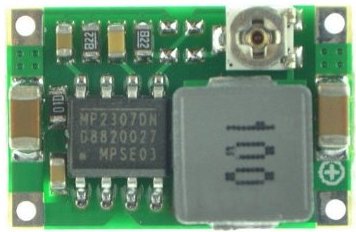
How to change the voltage of one DC supply to give other voltages
DC Voltage reduction/increase Guide
Regulators
How do I get multiple voltage supplies without using half a dozen wall plugs?
Various electrical devices on your layout may well require a range of different voltages, some may even be battery powered. This means the need for several different power supply units (PSU). Not only does this get expensive (and consume a lot of sockets/multi extensions), but you will also have a multitude of (dangerously) different voltages, which if mixed could cause a fire (I am scare mongering).
It is possible if you are capable of soldering, to use a Voltage Regulator (example = LM7805) and a few components on a strip board to make your own. That one just one supply is needed and can be reduced to the required voltages.
How do I reduce the brightness of my LED’s without using different resistors than those supplied or alter the all with one control?
You could build a PWM electronic circuit from discrete components or buy an off the shelf “Woodland Scenics Just Plug page” system or program an Arduino and transistorised output.
But here are a few ways to make more centrally controlled, use a computer and a Ledwiz or lots of DCC accessory decoders. Still works out expensive and complicated
So here are some cheap ones!
These use something called a ‘Buck converter’, essentially it is a DC to DC voltage converter (similar to the wall PSU but without the AC to DC conversion). They are tiny, handle massive power for their size and are cheap as chips!
Simple to wire, +VE and 0V in and +VE and 0V out, no other components
They benefit from a very wide input voltage range and output range, but essentialy the input needs to be a slightly larger value than required at the output, unlike discrete chips, if the output is much small than the input, they do not expend large quantities of heat!
If you require a voltage that is higher than the available input voltage, then obtain the Step-up type, just be careful of current, as if you require twice the voltage out, the input current will be twice that of the output current!
DC-DC SX1308 Converter Step-up
Functional features:
Oscillation frequency 1.2MHz
efficiency is as high as 95%
Circuit has short circuit protection, overheating protection function
10k to adjust potentiometer, adjust the output voltage
Technical parameters:
Maximum input voltage: DC 2-24V
Maximum output voltage: DC 2-28V
Switching frequency: 1.2MHz
Maximum current output: 2A
Adjustable Power Module Booster
Price guide = 1 for <£1
5 for <£3
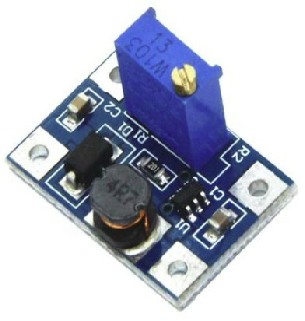
The smaller items are great when space is at a premium, the two larger with displays not only have a display, but can be adjusted easily with the buttons, so can be used for adjusting the output and are ideal as general purpose bench supplies!
Also the cased one shows how much current is being drawn.
Don’t forget that step down type can only give an output as high as the input (minus 1-2 volts)
DC-DC 12-24V To 5V 3A Adjustable Step Down Power Module Buck Mini Converter
Input Voltage:DC 4.5-24V
Output Voltage:integration adjustable and fixed output,back side can choose fiexd output voltage
Adjustable Range:0.8-17V,fixed voltage (1.8V 2.5V 3.3V 5V 9V 12V)
Output Current:3A (max),actual testing input 12V output 1.5A
Transform Efficiency:97.5%(max) (6.5 to 5V 0.7A)
Switch Frequency:500KHz
Output Ripple Wave:20mV (12V to 5V 3A) 20m band width
Operating Voltage:-40 Celsius-85 Celsius
Output Overvoltage Protection:no
Static Current:0.85MA
Load Adjust Rate:±1%
Voltage Adjust Rate:±0.5%
Dynamic Response Speed:5% 200uS
Output Short Circuit Protection:yes
Input Transposition Protection:no
Enable Control:yes
Price guide = 1 for <£1
10 for <£5
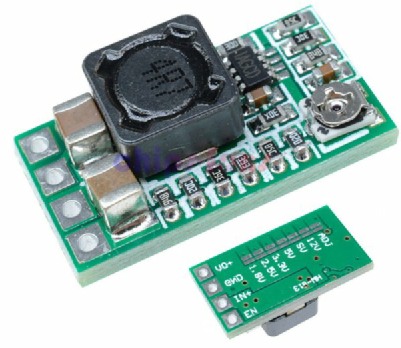
MT3608 2A Voltage Adjustable Step Up Booster Converter
.Electrical characteristics
The maximum output current: 2 a
The input voltage: 2 v ~ 24 v
The maximum output voltage: 28 v
Efficiency: max 93%
product size: 36 mm * 17 mm * 14 mm
Price guide = 1 for <£1
5 for <£3
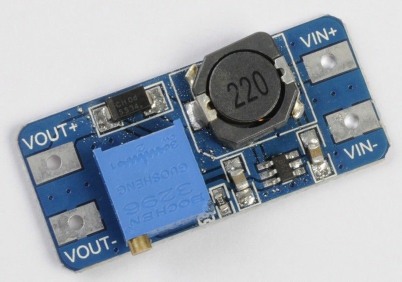
DC-DC step-down power supply adjustable push-button module with LCD display
Input Voltage: 5~23V, Max 23V, recommended to use within 20V
Input voltage must be higher than the output voltage 1V above
Output Voltage: 0~16.5V adjustable (It can save the last set voltage automatically)
Peak Current:Recommended use in 2A, accuracy of 1%, the minimum display 0.01A, less than 10mA will not be displayed.
Peak Current: 3A (Recommended use in 2A, accuracy of 1%, the minimum display 0.01A, less than 10mA will not be displayed.)
Conversion Efficiency: 95%
Load Regulation S(I) ≤0.8%
Voltage Regulation S(U) ≤0.8%
Size: 62 x 44 x 18mm
Weight: 45g
Price guide = <£4
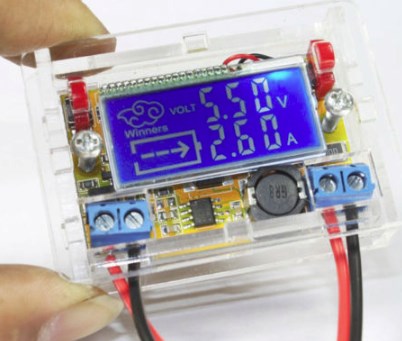
DC-DC Adjustable Step-Down Converter Power Supply Module 5A 75W Display FFE2
Specifications:
Size: approx. 60*37mm
Measure range: 0~40V ( please ensure that the input voltage is 4.5V or more)
Voltmeter error: ±0.05V
Input voltage: DC 4.0 ~ 38V. (Input voltage must be 1.5Vor more higher than the output voltage)
Output voltage: DC 1.25V ~ 36V continuously adjustable. (Input voltage must be 1.5V higher than the output voltage)
Output current: max 5A, recommended for use in the 4.5A.
Output power: up to 75W, more than 50W, Please enhance heat dissipation
Conversion efficiency: up to 96%
Operating frequency: 180KHZ
Load regulation: S (I) ≤0.8%
Voltage regulation: S (u) ≤0.8%
With overheat protection and short circuit protection.
With power indicator light.
Measure range 0~40V, voltmeter error ±0.05V.
With overheat protection and short circuit protection.
Price guide = <£4
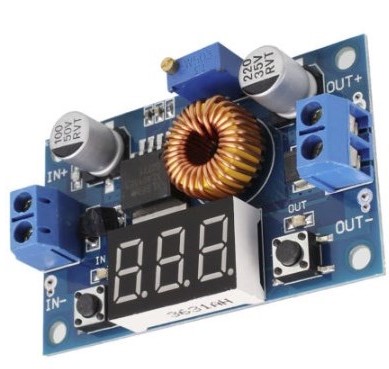
If you have an AC supply for the input, you must fit a bridge rectifier and capacitor to convert it to DC before applying to the input of these devices!
!
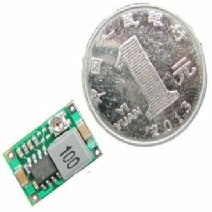
Example Voltages that might be needed:-
5V Arduino
6V Grain of wheat bulbs
3V micro motor and gearbox
14 – 16 V AC/DC European accessories
3.3V low power logic
3V+ for LED’s
12V Lamp posts
Price guide derived from items on Ebay from China with free shipping in 2018
If you have the right voltage and just want to dim the light level, consider a dimming circuit as explained here!